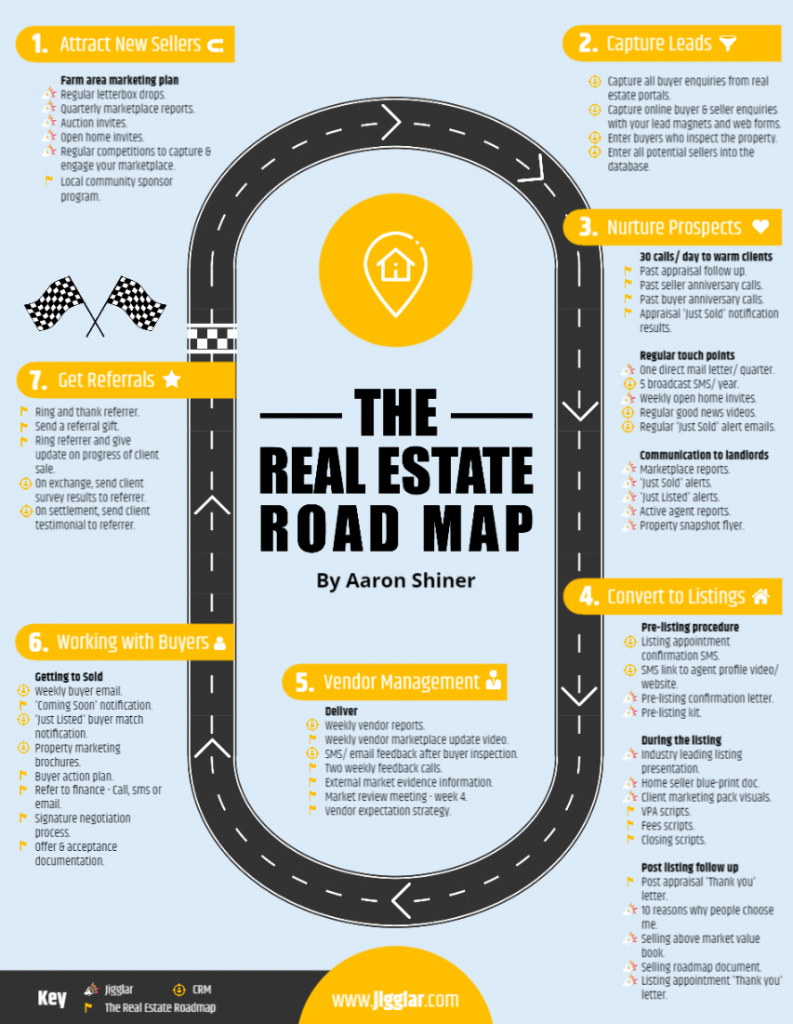Finding real estate leads and converting them into sales is a complex process that can take a long time. That process involves many steps which together make up what we call the real estate “roadmap” Understanding how that real estate roadmap looks is a great first step to growing your business as a realtor.
In this article, we’re going to introduce you to our real estate sales process flowchart. The flowchart covers seven steps and we’ll talk about what each stage involves. Let’s get right to it!
What Is the Real Estate Roadmap?
Finding leads and nurturing them is a multi-step process that can be very hard to visualize. To help you with that, we put together a comprehensive real estate sales process flowchart or roadmap, which you can find within the Jigglar library. Here’s a quick look at the full roadmap:

Every single step within that roadmap is crucial to the sales process. For example, if you skip the nurturing phase, you’ll be much less likely to land any listings. If you forget to ask for referrals, you leave potential leads on the table, and so on.
When you take the roadmap as a whole, you realize that the real estate sales process is a cycle. You collect leads, nurture them, transform them into listings, help buyers, get referrals, and start all over again. It sounds simple when we put it like that but in practice, getting the hang of every stage of the process can take years.
The Seven Phases of the Real Estate Sales Process Flowchart
Our real estate roadmap is divided into seven phases, starting with attracting new sellers. For each phase, we’ll discuss why it’s important and what actions we recommend that you take based on our experience.
1. Attract New Sellers
As a realtor, listings are at the core of your business. You can’t make money without listings and the more sellers that you attract, the more referrals that you’ll be able to get. However, you can’t rely on referrals alone to help you land business. Ideally, you’ll hustle for new sellers instead of waiting for them to come to you and that involves:
- Doing letterbox drops
- Sharing marketplace reports
- Inviting neighbors to auctions and open homes
- Holding competitions to foster engagement
- Sponsoring local community programs and events
Finding new sellers is all about getting your name out there. If owners know who you are and they have your contact information, they might reach out to you first when they decide it might be time to sell.
2. Capture Leads
The previous phase discussed active ways to collect leads. However, in 2021, the internet can do a lot of the hard work for you. For example, if you put up listings on real estate portals, you might get buyer inquiries. As a realtor, you need to have an online presence to help you capture leads by:
- Checking buyer inquiries from real estate portals
- Enabling interested parties to request inspections
- Offering contact forms on your website
- Sharing your business information on social media
Being active on social media and real estate portals is essential for a modern real estate business. Although a lot of buyers and sellers might only do business with someone they know personally, it’s becoming all too common to find realtors and properties online.
3. Nurture Prospects
The goal of nurturing is to take leads and convert them into customers. When you establish contact with a potential client, you can’t expect them to decide to trust you with their listings right away. To nurture a lead, you have to:
- Keep in regular contact with them (by sending postcards, flyers, emails, and more)
- Send them marketing materials and invitations periodically
Every lead requires a different level of nurturing. For some sellers, it might take only weeks to convince them to put up a listing. In other cases, you might have to nurture a lead for months. This is the step where you begin to build trust with sellers, so we can’t overstate its importance.
4. Convert to Listings
Once a lead “matures”, you’ll be able to reap its rewards in the shape of a listing. A successful listing isn’t just about adding a property to a real estate portal, though. When converting a lead into a listing, we recommend that you:
- Confirm the listing and send the seller an informational kit
- Prepare a listing presentation including visuals of the property
- Follow up with the seller after the listing is up
You’ve spent a lot of time and effort nurturing a lead, so it’s essential that they feel you have their back at every step of the process. A lot of realtors put up listings and then go AWOL until they start getting inquiries. That’s a quick way for sellers to lose trust in you, though.
5. Vendor Management
While a listing is up, it’s essential that you stay in touch with sellers and vendors. That means getting weekly reports, notifications when someone wants to inspect the property, feedback calls, and more. If a property stays on the market for a long time, you’ll also want to add market review meetings to your strategy.
6. Working With Buyers
Instead of waiting for buyers to come to you, it pays to be proactive when it comes to matching properties with interested parties. For example, if you have a presence on social media and an email list, you can send or post updates about new listings in the area.
Another great tactic is to keep a list of interested buyers who might have passed on other listings, so you can notify them if you have a property that matches their needs. Once you have a potential buyer, you’ll need to be able to walk them through the financing process and help make the sale as smooth as possible.
7. Get Referrals
If you manage to build trust with sellers and buyers, you should end up with more referrals than you’ll know what to do with. Selling a house is a big deal and if someone knows first-hand that you can do a good job, they’ll be sure to recommend you to their friends and family if they decide to list a property.
Instead of just waiting for referrals, don’t be afraid to ask for them. Send surveys to past clients to see what they thought about your services, ask for customer testimonials when you close deals, and you’ll get plenty of feedback rolling in.
Conclusion
The full real estate sales process flowchart can seem a bit intimidating. However, the roadmap involves processes that you’re already familiar with as a realtor. By understanding how each phase ties into each other, you’ll be able to greatly improve your sales technique.
If you want to share the real estate sales process flowchart with customers or other realtors, you can find it within the Jigglar archives. Helping sellers understand how the sales process works can be a great way to build engagement and you can print the flowchart as a mailer or flyer.
Do you want to take a closer look at the real estate sales process flowchart? Try out Jigglar for free and find the template within our archives.




